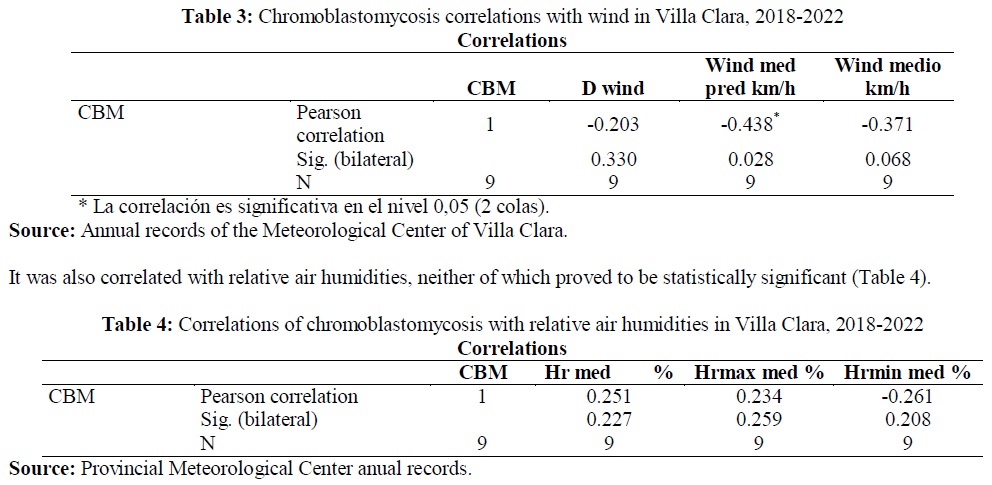Etiological Diagnosis and Correlation of Chromoblastomycosis with Climatic Variables of Weather Stations in Villa Clara, Cuba
DOI:
https://doi.org/10.31033/abjar.2.4.7Keywords:
chromoblastomycosis, fonsecaea pedrosoi, climatic variables, villa claraAbstract
In Villa Clara province, Cuba, microorganisms and climatic conditions coexist for the development of the infectious entity chromoblastomycosis. Besides, there is a high percentage of agricultural and handicraft workers exposed to acquiring this infection. The objective of the research consisted in describing the etiological diagnosis and correlating chromoblastomycosis with average climatic variables of the meteorological stations located in Villa Clara. Between 2018-2022, a descriptive, cross-sectional study was conducted in a population of 25 patients diagnosed with chromoblastomycosis by anatomopathological and microbiological studies. Absolute frequencies were used as a summary measure, and for correlation with climatic data from the five meteorological stations, inferential statistics. Of the total number of patients, 92% were diagnosed by anatomopathological studies and only 2/8% had mycological studies, in which the species Fonsecaea pedrosoi was isolated. There was a significant correlation between mean temperature (p=0.045) and mean predicted wind (p=0.028) and the number of cases. This was not the case with relative air humidity (p>0.05). It is concluded that in Villa Clara province, only the etiological agent F. pedrosoi was the cause of the disease during the period studied, with a significant relationship between the disease and the average climatic variables mean temperature and mean predicted wind.
Downloads
References
Hotez PJ, Aksoy S, Brindley PJ, & KamhawiI S. (2020). World neglected tropical diseases day. PLoS Negl Trop Dis, 14(1). e0007999. Available at: https://doi. org/10.1371/journal.pntd.0007999.
Queiroz, Telles F. (2015). Chromoblastomycosis: a neglected tropical disease. Rev Inst Med Trop, 57(Supplement 19), 46-50. Available at: http://www.ncbi.nlm.nih.gov.
Hay, RW, Denning, D, Bonifaz, A, Queiroz-Telles, F, Beer, K, & Bustamante, B, et al. (2019). The diagnosis of fungal neglected tropical diseases (Fungal NTDs) and the role of investigation and laboratory tests: An expert consensus report. Trop Med Infect Dis, 4(4), 122. Available at: www.mdpi.com/journal/tropicalmed.
Wagner, CL, Santos, D, Pedrozo, SCM, Aparecida, VV, Queiroz-Telles, F, Messias, RA, & Sybren, HG, et al. (2021). The global burden of chromoblastomycosis. PLoS Negl Trop Dis, 15(8). Available at: https://doi.org/10.1371/journal.pntd.0009611.
Botello, MHM, Vanden, en den Medina L, Jaramillo, AF, & Marulanda, GMA. (2021). Chromomycosis, a neglected tropical disease: a review of a clinical case report. Rev Association Colomb Dermatology, 29(1), 45-55. Available at: https://revista.asocolderma.org.co/index.php/asocolderma/a.
Le, TA, Nguyen, KL, Pham, MH, Vi, TT, & Do, NA. (2019). Case report: A case of chromoblastomycosis caused by fonsecaea pedrosoi in Vietnam. Mycopathology, 184(1), 115-119. Available at: https://doi.org/10.1007/s11046-018-0284-3.
Díaz, AJG, Taboas, GM, & Dube, DA. (1978). Chromoblastomycosis in Cuba, retrospective clinical and epidemiologic studies of 72 patients. Rev Cubana Med Trop, 30(2), 95-108. Available at: https://pubmed.ncbi.nlm.nih.gov/368916/1/1.
García, GD, Durán, MN, Rodríguez, RJA, Mesa, CL, & Artiles, MD. (2022). Aetiological diagnosis and epidemiology of chromoblastomycosis. Acta Médica del Centro, 16(2), 7. Available at: http://scielo.sld.cu/scielo.php?script=sci_arttex&pid=S2709-79272022000200272&Ing=es.
Bonifaz, A, Robles, Tenorio A, & Tirado, Sánchez A. (2022). Climate change impact on Chromoblastomycosis. in: Frías de León MG, Brunner Mendoza C, Reyes Montes MR, Duarte Escalante E, editors. The Impact of Climate Change on Fungal Diseases. Switzerland. Springer Nature, 115-130.
Casadevall, A. (2019). Global catastrophic threats from the fungal kingdom: Fungal catastrophic threats. In: Current Topics in Microbiology and Immunology. Springer Nature, 21-32. Available at: https://doi.org/10.1007/82_2019_161.
Arenas, GR. (2014). Cromoblastomicosis. En: de León Fraga J, Salas Castillo E, editors. Illustrated medical mycology. Vol. 1. 5ta ed. México: McGraw-Hill, 173-194.
García, GD, López, PM & Adjudah, TC. (2020a). Microbiological diagnosis in a patient with chromomycosis. Medicentro Electrónica, 24(3), 691-98. Available at: http: //scielo.sld.cu/scielo.php? script=sci_arttext&pid=S1029-30432020000300691&Ing=es.
Wattiez, V, García, J, Aquino, N, Insaurralde, S, Mendoza, G, & Celia, L, et al. (2017). Chromomycosis: casuistry of the dermatology service of the national hospital, period 1991-2015. Rev Virtual Soc Parag Med Int, 4(2), 27-33. Available at: http://scielo.iics.una.py/scielo.php?script=sci_arttext&pid=S2312-38932017000200027. https://doi.org/10.18004/rvspmi/2312-3893/2017.04(02)27-033.
García, GD, Guerra, MM, & Choy, MA. (2020b). Behavior of chromoblastomycosis in Manicaragua, Villa Clara, Cuba. Medicentro Electrónica, 27(3), 5. Available at: http://medicentro.sld.cu/index.php/medicentro/article/download/3967/3117.
Simón, RD, Moya, DS, & Abreu, GM. (1998). Chromomycosis: Dematiaceous fungi involved in etiology. Rev Cubana Med, 37(3), 5. Available at: http://scieloprueba.sld.cu/scielo.php?script=sci_arttext&pid=S0034-75231998000300002&lng=es.
Oyarzún, GM, Lanas, ZF, Wolff, RM, & Quezada, LA. (2021). Impact of climate change on health. Rev Med Chile, 149, 738-746. Available at: https://repositorio.uchile.cl/bitstream/handle/2250/185594/Impacto-del-cambio-climatico.pdf?sequence=1&isAllowed=y.
Benedict, K, & Park, BJ. (2014). Invasive fungal infections after natural disasters. Emerging Infectious Diseases, 20(3), 349-355.
Sumba, López MM. (2022). Microbiological diagnosis of chromoblastomycosis in Latin America [thesis]. Riobamba: National University of Chimborazo. Available at: http://dspace.unach.edu.ec/handle/51000/941.
Bonifaz, A. (2015). Cromoblastomicosis. in: Bonifaz Trujillo JA. Basic Medical Mycology, 1. (5ta ed.). México: McGraw-Hill Education, pp. 231-246.

Downloads
Published
How to Cite
Issue
Section
ARK
License
Copyright (c) 2023 Dianiley García Gómez, Ricardo Osés Rodríguez, Daniel Artiles Martínez, María Teresa Illnait Zaragozí, David del Valle Laveaga, Hans García Garcés, Rigoberto Fimia Duarte

This work is licensed under a Creative Commons Attribution 4.0 International License.
Research Articles in 'Applied Science and Biotechnology Journal for Advanced Research' are Open Access articles published under the Creative Commons CC BY License Creative Commons Attribution 4.0 International License http://creativecommons.org/licenses/by/4.0/. This license allows you to share – copy and redistribute the material in any medium or format. Adapt – remix, transform, and build upon the material for any purpose, even commercially.










